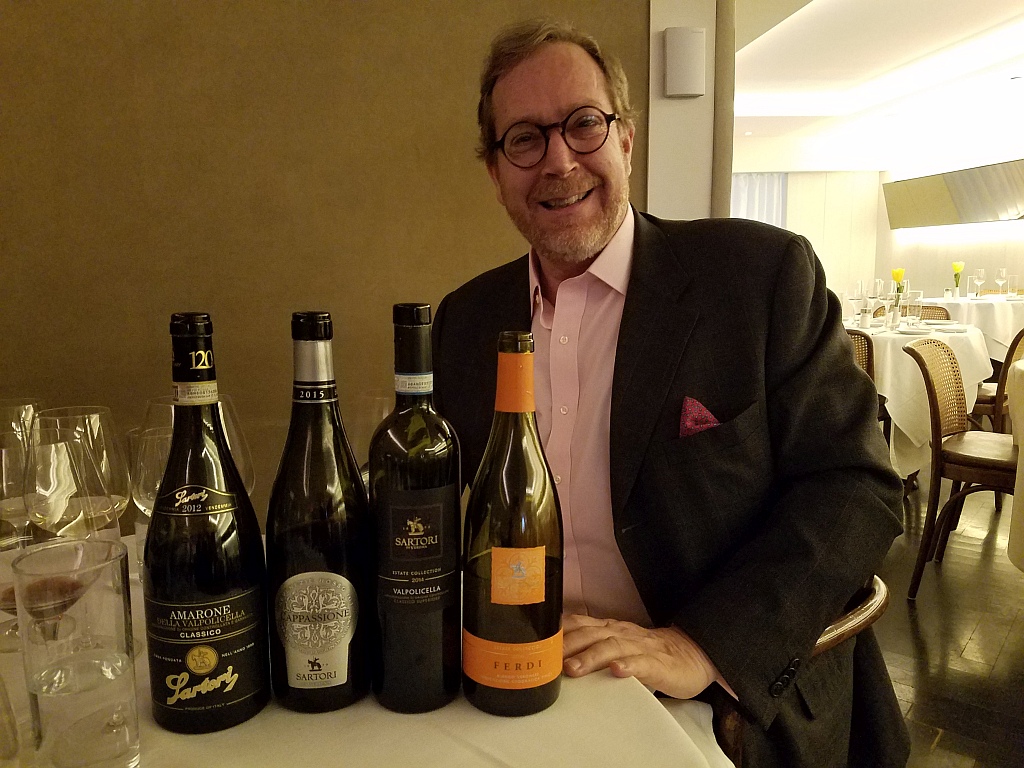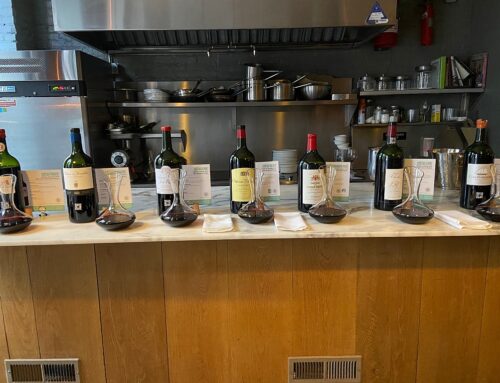Andrea Sartori at Il Gattopardo, NYC
Verona, the city in northern Italy made for lovers by Shakesphere’s play, “Romeo and Juliet,” is also the gateway for wine lovers. It is there that [inlinetweet prefix=”#thewineodyssey” tweeter=”” suffix=””]Sartori’s elegant Amarone and Valpolicella wines answer Juliet’s question, “What’s in a name?”[/inlinetweet]
In Latin, Sartor means tailor—one who patches and mends. While the Sartori family has no record of tailors, it was 1898 when Pietro Sartori bought the Villa Maria vineyard and cellar in di Negrar, a village in the Valpolicella district, to “mend” the problem of inconsistent supply of quality wine at his hotel. His son, Regolo Sartori, developed the wine sector into the family’s primary business, and, in turn, in the 1950s, his two sons marketed and sold the wine beyond Italy’s borders.
Last month, I met the current leader, fourth-generation Andrea Sartori at Il Gattopardo, an excellent Italian restaurant on 54th street opposite New York’s Museum of Modern Art. Andrea, who graduated from business schools in northern Italy and attended New York’s Columbia University, is thoroughly Americanized from years of introducing his wines across our country. At our luncheon, he presented the family’s Estate Collection, made by the renown enologist Franco Bernabei.
Andrea poured the 2016 Sartori Estate Collection Ferdi Bianco Veronese, noting the wine was named for his paternal grandmother Fernanda, who was known as Ferdi. The wine is made from 100% garganega, the white grape of the region, and is dried for 40 days using the same method as that for the red grapes of Amarone.
The drying process reduces the water and concentrates the sugar and phenolic compounds in the grapes. Fermentation followed in oak barrels and stainless-steel tanks. The wines gain complexity with six months aging in the vessels before blending and bottling. This time and attention created a very perfumed 2016 Sartori Ferdi billowing with aromas of white flowers and pears. A pastry cream texture and flavor was laced with a honey accent. 88 points. Retail prices range from $14 to $20.
Until the 1990s, Valpolicella was often a thin, acidic cherry-flavored wine mass produced by large wine companies from grapes grown on the valley floor, in the wrong soil and with poor drainage.That style still occurs, but Sartori’s Valpolicella is much better than that.
If, again, you ask “What is in a name?” you’ll get an earful (or mouthful) in the 2014 Sartori Estate Collection Valpolicella Classico Superiore. Classico refers to the original zone before regulators expanded the Valpolicella area in 1968. It boasts superior drainage, more direct sunlight and restrictive production rules, leading to riper, healthier grapes with better tannins and phenolic content.
The superior designation means the wine has at least 12 percent alcohol and was aged at least one year in barrel, tanks, bottle, or a combination.
Sartori’s hillside vineyards produced a blend of 45% corvina veronese, 30% corvinone, 20% rondinella and 5% croatina for its 2014 Valpoicella. After fermentation, Bernabei divided the wine into oak barrels and stainless-steel tanks for 15 months of aging, followed by four months in the bottle. This “stitched” together a stylish black-cherry hue with black-pepper and blackberry aromas and flavors. The vineyards’ volcanic soil gave a gravelly backbone and firm mouthfeel. This wine dispels the thought of Valpolicella as a thin, acidic red wine. 89 points. Retail prices are $15 to $20.
The 2012 Sartori Amarone della Valplicella Estate Collection 120 marks the anniversary of the winery’s founding in 1898. It’s a blend of 50% corvina veronese, 30% corvinone, 15% rondinella and 5% cabernet sauvignon (as a purist, I wish that international grape was not included). The classic drying process on straw mats or plastic trays in the “fruittaio”—a room that controls the humidity—takes about 100 days, and after fermentation, the wines are blended and spend the next three years quietly aging in Slovanian oak casks.
Bernabei’s choice of traditional Slovanian oak over the modern style of French oak barriques is significant. The Sartori 2012 Amarone is filled with delightful floral, blackberry, prune and black-plum aromas without a trace of the vanilla infusion that French oak barrels impart. On the palate, the ripe fruit flavors are front and center with mellow tannins and a mineral backbone, rather than the slick, velvety texture that French oak barrels give to wine. His choice of the oak honors the history and anniversary of Sartori’s Amarone. 90 points. Only a very small amount of this wine was allocated to the American market; expect to pay about $120.
The name of the 2015 Sartori L’ Appassione Veronese Rosso merges passion and appassimento, the process of drying the grapes in the fruittaio. The L’ Appassione grapes—corvina veronese, corvinone, merlot and cabernet sauvignon—are only partially dried, concentrating the sugar, and the grape’s color and flavor, while softening the tannins.
This modern wine blends the richness developed from the drying process with the freshness of newly harvested ripe grapes. Garnet colored, it’s peppery on the nose and palate with blackberry and bay leaf aromas; black-plum and mineral flavors cross the palate on refined tannins. It’s ideal with soppressata, porchetta (my favorite, finochietta) and grilled meats. 90 points. Retail pricing is remarkable at $14 to $17.
What’s in a name? In Sartori, it’s attention to detail that stitches together tradition, modernity and value.
Photos by John Foy










Leave A Comment